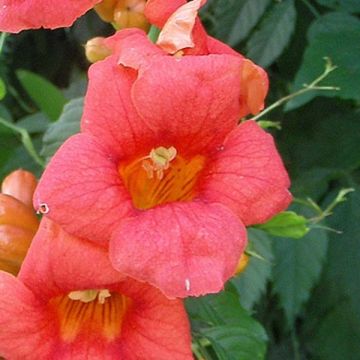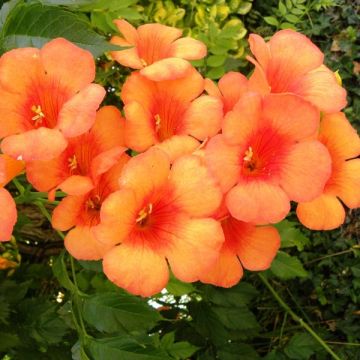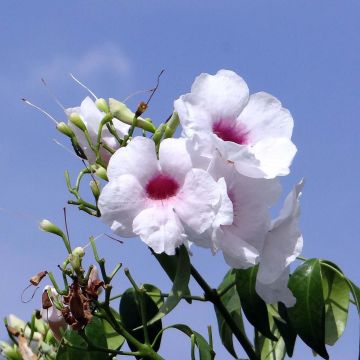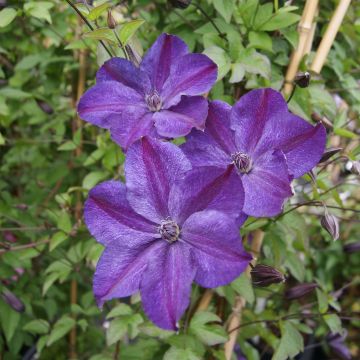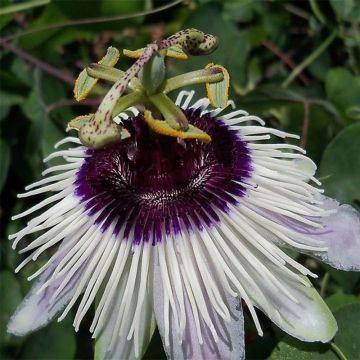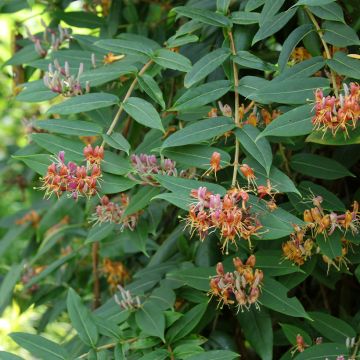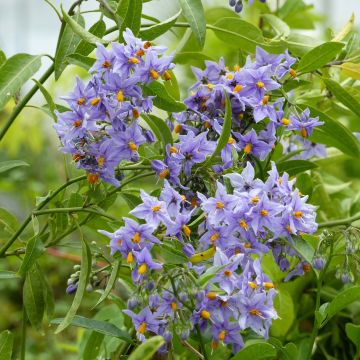Shipping country and language
Your country of residence may be:
Your country of residence is:
For a better user experience on our website, you can select:
Your shipping country:
-
Andorra
-
Austria
-
Belgium
-
Bulgaria
-
Canada
-
Chile
-
Croatia
-
Cyprus
-
Czechia
-
Denmark
-
Estonia
-
Finland
-
France
-
Germany
-
Greece
-
Hungary
-
Iceland
-
Ireland
-
Italy
-
Latvia
-
Lithuania
-
Luxembourg
-
Malta
-
Monaco
-
Netherlands
-
Poland
-
Portugal
-
Romania
-
Slovakia
-
Slovenia
-
Spain
-
Sweden
-
Switzerland
-
United Kingdom
We only deliver seed and bulb products to your country. If you add other products to your basket, they cannot be shipped.
Language:
-
French
-
German
-
Spanish
-
English
-
Italian
My Account
Hello
My wish lists
Log in / Register
Existing customer?
New customer?
Create an account to track your orders, access our customer service and, if you wish, make the most of our upcoming offers.


Tecoma capensis Tropical Twist - Cape honeysuckle
Tecoma capensis Tropical Twist - Cape honeysuckle
Tecoma capensis Tropical Twist ®
Cape honeysuckle, Cape trumpet flower
Order in the next for dispatch today!
Dispatch by letter from €3.90.
Delivery charge from €5.90 Oversize package delivery charge from €6.90.
More information
This item is not available in your country.
Schedule delivery date,
and select date in basket
This plant carries a 6 months recovery warranty
More information
We guarantee the quality of our plants for a full growing cycle, and will replace at our expense any plant that fails to recover under normal climatic and planting conditions.
From €5.90 for pickup delivery and €6.90 for home delivery
Express home delivery from €8.90.
Does this plant fit my garden?
Set up your Plantfit profile →
Description
Tecoma capensis 'Tropical Twist' is a beautiful cultivar of Cape Honeysuckle. Also known as Cape Trumpet Vine, it is recognisable by its trumpet-shaped flowers. It is a trailing bush, unable to attach itself to a support. 'Tropical Twist' offers large, vibrant, yellow and orange tubular flowers from May to October, which are loved by pollinators. The light green foliage is also noteworthy, with opposite, pinnate, shiny leaflets. This South African plant loves sun and heat and tolerates summer drought once well-established in deep, frost-free soil. It also makes a beautiful addition to a terrace or balcony but should be protected from frost during winter.
Tecoma capensis belongs to the Bignoniaceae family. It is native to the Eastern Cape province in South Africa and southern Mozambique. It thrives in mild climates: as an adult, it can withstand brief frosts of around -7 /-8°C in well-drained soil, regrowing from the crown in spring if properly protected. Its growth is quite rapid and its habit is upright and trailing. In ideal conditions, it can reach an average height of 5m in the ground in very mild climates. If it dies back every year due to frost, it will rarely exceed 2.50m high. In a container, it reaches about 1.50m high and 1m in spread. The stems of Tecoma capensis are punctuated with lenticels, small round and light marks that distinguish them from the exfoliating bark of trumpet vines. They bear foliage that is evergreen if there is no winter frost. The leaves are arranged oppositely on the branches. Each leaf is divided into 5 to 9 oblong to oval, irregularly toothed leaflets, with an intense and glossy green colour. Flowering begins in late summer, around late August or early September, and continues into autumn if the weather permits. The flowers are long, narrow tubes, slightly curved and upright, measuring 6 to 8 cm in length, slightly flaring at the end. The flower is adorned with beautiful protruding stamens and a long style. They are a beautiful bright orange. This flowering attracts many pollinating insects. It is followed by elongated pods measuring up to 25 cm long, which contain numerous winged seeds.
Tecoma 'Tropical Twist', obtained in the Netherlands in 2016, is more sensitive to cold than the botanical species, as it is known to lose its foliage below 10°C and tolerate temperatures as low as +2°C without damage. It can be overwintered as an indoor plant or simply in a frost-free room with moderate watering. It stands out with its earlier and longer flowering period compared to the species, as well as its bright yellow flowers with a soft orange on the outside.
Cape Honeysuckle 'Tropical Twist' blooms for a long time in a hedge, shrub border, or container with a climbing support. In the garden or on the terrace, it complements the blue flowers of Cape Leadwort or Ceratostigma willmottianum, whose foliage turns red in autumn. In very mild climates, it can be planted as a hedge and pruned annually after flowering. In very dry summer climates, occasional deep watering will be appreciated.
Report an error about the product description
Plant habit
Flowering
Foliage
Botanical data
Tecoma
capensis
Tropical Twist ®
Bignoniaceae
Cape honeysuckle, Cape trumpet flower
Tecomaria capensis, Bignonia capensis
Cultivar or hybrid
Other Campsis - Trumpet Creeper
Planting and care
Tecoma 'Tropical Twist' is best planted in spring, to allow the plant to establish itself well before winter. It is undemanding of the nature of the soil, as long as it is rich enough and well-drained: a mixture of compost and garden soil, supplemented with some gravel, should be suitable.
Its resistance to summer drought is commendable, once it is well rooted in deep soil: 2 to 3 thorough waterings during the summer are necessary in dry Mediterranean regions. The Cape honeysuckle loves heat and prefers a sunny exposure, except in the south where it will also thrive in partial shade. Plant it along a well-exposed wall or provide it with the shelter of other evergreen bushes that will protect it from the cold, dry winds of winter. Pruning is not essential, but it tolerates it well. The bush can be pruned after flowering to limit its size or encourage branching.
It can also be trained into a large, bushy shrub with regular pruning or by training its branches on a structure. Its basal stems, whose nodes easily root upon contact with the ground, allow this plant to spread in width. This characteristic is often used to create large formal or informal hedges in its native region.
Planting period
Intended location
Care
This item has not been reviewed yet - be the first to leave a review about it.
Summer flowering climbers
Haven't found what you were looking for?
Hardiness is the lowest winter temperature a plant can endure without suffering serious damage or even dying. However, hardiness is affected by location (a sheltered area, such as a patio), protection (winter cover) and soil type (hardiness is improved by well-drained soil).

Photo Sharing Terms & Conditions
In order to encourage gardeners to interact and share their experiences, Promesse de fleurs offers various media enabling content to be uploaded onto its Site - in particular via the ‘Photo sharing’ module.
The User agrees to refrain from:
- Posting any content that is illegal, prejudicial, insulting, racist, inciteful to hatred, revisionist, contrary to public decency, that infringes on privacy or on the privacy rights of third parties, in particular the publicity rights of persons and goods, intellectual property rights, or the right to privacy.
- Submitting content on behalf of a third party;
- Impersonate the identity of a third party and/or publish any personal information about a third party;
In general, the User undertakes to refrain from any unethical behaviour.
All Content (in particular text, comments, files, images, photos, videos, creative works, etc.), which may be subject to property or intellectual property rights, image or other private rights, shall remain the property of the User, subject to the limited rights granted by the terms of the licence granted by Promesse de fleurs as stated below. Users are at liberty to publish or not to publish such Content on the Site, notably via the ‘Photo Sharing’ facility, and accept that this Content shall be made public and freely accessible, notably on the Internet.
Users further acknowledge, undertake to have ,and guarantee that they hold all necessary rights and permissions to publish such material on the Site, in particular with regard to the legislation in force pertaining to any privacy, property, intellectual property, image, or contractual rights, or rights of any other nature. By publishing such Content on the Site, Users acknowledge accepting full liability as publishers of the Content within the meaning of the law, and grant Promesse de fleurs, free of charge, an inclusive, worldwide licence for the said Content for the entire duration of its publication, including all reproduction, representation, up/downloading, displaying, performing, transmission, and storage rights.
Users also grant permission for their name to be linked to the Content and accept that this link may not always be made available.
By engaging in posting material, Users consent to their Content becoming automatically accessible on the Internet, in particular on other sites and/or blogs and/or web pages of the Promesse de fleurs site, including in particular social pages and the Promesse de fleurs catalogue.
Users may secure the removal of entrusted content free of charge by issuing a simple request via our contact form.
The flowering period indicated on our website applies to countries and regions located in USDA zone 8 (France, the United Kingdom, Ireland, the Netherlands, etc.)
It will vary according to where you live:
- In zones 9 to 10 (Italy, Spain, Greece, etc.), flowering will occur about 2 to 4 weeks earlier.
- In zones 6 to 7 (Germany, Poland, Slovenia, and lower mountainous regions), flowering will be delayed by 2 to 3 weeks.
- In zone 5 (Central Europe, Scandinavia), blooming will be delayed by 3 to 5 weeks.
In temperate climates, pruning of spring-flowering shrubs (forsythia, spireas, etc.) should be done just after flowering.
Pruning of summer-flowering shrubs (Indian Lilac, Perovskia, etc.) can be done in winter or spring.
In cold regions as well as with frost-sensitive plants, avoid pruning too early when severe frosts may still occur.
The planting period indicated on our website applies to countries and regions located in USDA zone 8 (France, United Kingdom, Ireland, Netherlands).
It will vary according to where you live:
- In Mediterranean zones (Marseille, Madrid, Milan, etc.), autumn and winter are the best planting periods.
- In continental zones (Strasbourg, Munich, Vienna, etc.), delay planting by 2 to 3 weeks in spring and bring it forward by 2 to 4 weeks in autumn.
- In mountainous regions (the Alps, Pyrenees, Carpathians, etc.), it is best to plant in late spring (May-June) or late summer (August-September).
The harvesting period indicated on our website applies to countries and regions in USDA zone 8 (France, England, Ireland, the Netherlands).
In colder areas (Scandinavia, Poland, Austria...) fruit and vegetable harvests are likely to be delayed by 3-4 weeks.
In warmer areas (Italy, Spain, Greece, etc.), harvesting will probably take place earlier, depending on weather conditions.
The sowing periods indicated on our website apply to countries and regions within USDA Zone 8 (France, UK, Ireland, Netherlands).
In colder areas (Scandinavia, Poland, Austria...), delay any outdoor sowing by 3-4 weeks, or sow under glass.
In warmer climes (Italy, Spain, Greece, etc.), bring outdoor sowing forward by a few weeks.

